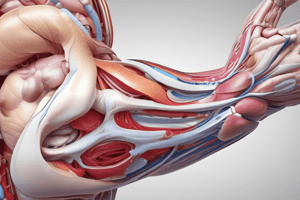Podcast
Questions and Answers
What is the primary function of the radius bone?
What is the primary function of the radius bone?
- Running from the elbow to the thumb-side of the forearm (correct)
- Running from the elbow to the little finger side
- Located on the medial aspect of the forearm
- Extending from the shoulder to the elbow
The ulna bone is shorter than the radius bone.
The ulna bone is shorter than the radius bone.
False (B)
Name the bone that is located on the lateral aspect of the forearm.
Name the bone that is located on the lateral aspect of the forearm.
Radius
The ulna bone runs from the elbow to the side of the ______.
The ulna bone runs from the elbow to the side of the ______.
Match the bones with their location:
Match the bones with their location:
What type of joint is the elbow classified as?
What type of joint is the elbow classified as?
The elbow supports both physiological and accessory movements.
The elbow supports both physiological and accessory movements.
What are the primary factors that check elbow motions?
What are the primary factors that check elbow motions?
The elbow joint is primarily responsible for ________ and ________ movements.
The elbow joint is primarily responsible for ________ and ________ movements.
Match the following structures with their functions:
Match the following structures with their functions:
What is a potential mechanism of injury at the elbow complex?
What is a potential mechanism of injury at the elbow complex?
The surrounding tissues of the elbow do not play a role in joint stability.
The surrounding tissues of the elbow do not play a role in joint stability.
Explain the significance of understanding the elbow and forearm structures for physiotherapy.
Explain the significance of understanding the elbow and forearm structures for physiotherapy.
Flashcards
Humerus
Humerus
The bone in the upper arm that connects the shoulder to the elbow.
Radius
Radius
The bone on the thumb side of the forearm that runs from the elbow to the wrist.
Ulna
Ulna
The bone on the little finger side of the forearm that runs from the elbow to the wrist.
Elbow Joint
Elbow Joint
Signup and view all the flashcards
Ossification
Ossification
Signup and view all the flashcards
Elbow Joint Type
Elbow Joint Type
Signup and view all the flashcards
Elbow Joint Movements
Elbow Joint Movements
Signup and view all the flashcards
Elbow Joint Accessory Movements
Elbow Joint Accessory Movements
Signup and view all the flashcards
Elbow Joint Stability
Elbow Joint Stability
Signup and view all the flashcards
Elbow Joint Injuries
Elbow Joint Injuries
Signup and view all the flashcards
Humeroulnar Joint
Humeroulnar Joint
Signup and view all the flashcards
Humeroradial Joint
Humeroradial Joint
Signup and view all the flashcards
Proximal Radio-Ulna Joint
Proximal Radio-Ulna Joint
Signup and view all the flashcards
Study Notes
Functional Anatomy of Upper Extremity (PTAU 4113)
- Course: Diploma in Physiotherapy
- Unit: 4
- Topic: Elbow & Radio-ulnar Joint
- Course Identifier: PTAU 4113
- School: School of Nursing and Allied Health
- Institution: UOW (University of Wollongong) Malaysia
- Prepared by: Ms. Vaneeyshaa Chandran
- Date: 13/11/2024
Elbow Joint Bones
- Humerus: Bone from shoulder to elbow
- Radius: Bone from elbow to thumb side of forearm
- Ulna: Bone from elbow to little finger side of forearm (longer than radius)
Studying That Suits You
Use AI to generate personalized quizzes and flashcards to suit your learning preferences.




